Hitachi C 10FS User Manual
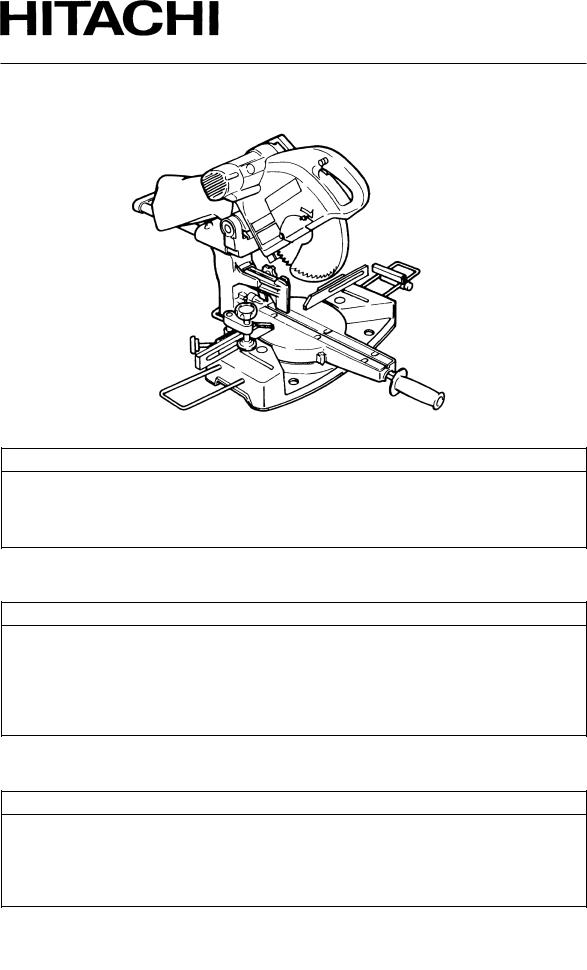
MODEL |
C 10FS |
SLIDE COMPOUND SAW |
MODELE |
SCIE A COUPE D’ONGLET RADIALE |
|
MODELO |
|
TRONZADORA RADIAL ABATIBLE |
INSTRUCTION MANUAL AND SAFETY INSTRUCTIONS
 WARNING
WARNING
Improper and unsafe use of this power tool can result in death or serious bodily injury! This manual contains important information about product safety. Please read and understand this manual before operating the power tool. Please keep this manual available for others before they use the power tool.
MODE D’EMPLOI ET INSTRUCTIONS DE SECURITE
 AVERTISSEMENT
AVERTISSEMENT
Une utilisation incorrecte et dangereuse de cet outil motorisé peut entraîner la mort ou de sérieuses blessures corporelles!
Ce mode d’emploi contient d’importantes informations à propos de la sécurité de ce produit. Prière de lire et d’assimiler ce mode d’emploi avant d’utiliser l’outil motorisé. Garder ce mode d’emploi à la disponibilité des autres utilisateurs avant qu’ils utilisent l’outil motorisé.
MANUAL DE INSTRUCCIONES E INSTRUCCIONES DE SEGURIDAD
 ADVERTENCIA
ADVERTENCIA
¡La utilización inapropiada e insegura de esta herramienta eléctrica puede resultar en lesiones serias o en la muerte!
Este manual contiene información importante sobre la seguridad del producto. Lea y comprenda este manual antes de utilizar la herramienta eléctrica. Guarde este manual para que puedan leerlo otras personas antes de que utilicen la herramienta eléctrica.
DOUBLE INSULATION
DOUBLE ISOLATION
AISLAMIENTO DOBLE
|
|
CONTENTS |
|
|
|
English |
|
|
Page |
||
|
Page |
|
|
||
|
|
|
|
||
|
|
|
|
||
IMPORTANT INFORMATION ..................................... |
3 |
OPTIONAL ACCESSORIES .................................... |
10 |
||
MEANINGS OF SIGNAL WORDS ............................... |
3 |
APPLICATIONS ........................................................... |
10 |
||
SAFETY |
|
PREPARATION BEFORE OPERATION ..................... |
11 |
||
IMPORTANT SAFETY INSTRUCTIONS |
|
BEFORE USING ........................................................... |
12 |
||
FOR USING ALL POWER TOOLS ............................ |
3 |
BEFORE CUTTING ...................................................... |
13 |
||
REPLACEMENT PARTS ............................................... |
6 |
PRACTICAL APPLICATIONS .................................... |
15 |
||
USE PROPER EXTENSION CORD ............................... |
6 |
SAW BLADE MOUNTING |
|
||
DOUBLE INSULATION FOR |
|
AND DISMOUNTING ............................................. |
23 |
||
SAFER OPERATION .................................................. |
7 |
OVERLOAD PROTECTIVE DEVICE |
|
||
OPERATION AND MAINTENANCE |
|
FOR POLY-V-BELT .................................................. |
24 |
||
NAME OF PARTS .......................................................... |
8 |
MAINTENANCE AND INSPECTION ........................ |
24 |
||
SPECIFICATIONS ......................................................... |
9 |
SERVICE AND REPAIRS ............................................ |
26 |
||
ACCESSORIES ............................................................ |
10 |
PARTS LIST ................................................................. |
78 |
||
STANDARD ACCESSORIES .................................. |
10 |
|
|
|
|
|
|
|
|
|
|
|
|
TABLE DES MATIERES |
|
|
||
Français |
|
|
|
|||
|
|
|
|
|
|
|
|
|
Page |
|
|
Page |
|
|
|
|
|
|
||
|
|
|
|
|
||
INFORMATIONS IMPORTANTES ............................ |
|
27 |
ACCESSOIRES ............................................................ |
34 |
||
SIGNIFICATION DES MOTS D’AVERTISSEMENT |
..... 27 |
ACCESSOIRES STANDARD .................................. |
34 |
|||
SECURITE |
|
|
ACCESSOIRES EN OPTION ................................... |
34 |
||
CONSIGNES DE SECURITE RELATIVES AUX |
|
APPLICATIONS ........................................................... |
34 |
|||
OUTILS ÉLECTRIQUES .......................................... |
|
27 |
PRÉPARATION AVANT L’UTILISATION ................. |
35 |
||
PIECES DE RECHANGE .............................................. |
|
31 |
AVANT L’UTILISATION ............................................. |
36 |
||
UTILISER LE CORDON DE RALLONGE |
|
AVANT LA COUPE ...................................................... |
37 |
|||
APPROPRIÉ ............................................................ |
|
31 |
APPLICATIONS PRATIQUES .................................... |
39 |
||
DOUBLE ISOLATION POUR UN |
|
|
INSTALLATION ET RETRAIT DE LA LAME ............ |
48 |
||
FONCTIONNEMENT PLUS SUR ........................... |
|
31 |
DISPOSITIF DE PROTECTION ANTI-SURCHARGE |
|||
UTILISATION ET ENTRETIEN |
|
|
DE LA POLY-COURROIE EN V .............................. |
49 |
||
NOM DES PIÈCES ...................................................... |
|
32 |
ENTRETIEN ET INSPECTION .................................... |
49 |
||
SPÉCIFICATIONS ...................................................... |
|
33 |
SERVICE APRÈS-VENTE ET RÉPARATIONS .......... |
51 |
||
|
|
|
|
|
|
|
|
|
|
ÍNDICE |
|
|
|
Español |
|
|
|
Página |
||
|
|
|
|
|
||
|
Página |
|
|
|||
|
|
|
|
|||
|
|
|
|
|||
INFORMACIÓN IMPORTANTE ................................. |
52 |
ACCESORIOS .............................................................. |
59 |
|||
SIGNIFICADO DE LAS PALABRAS CLAVE ............ |
52 |
ACCESORIOS ESTÁNDAR ......................................... |
59 |
|||
SEGURIDAD |
|
|
ACCESORIOS OPCIONALES .................................... |
59 |
||
NORMAS DE SEGURIDAD PARA LAS |
|
|
APLICACIONES ........................................................... |
59 |
||
HERRAMIENTAS ELÉCTRICAS ................................... |
52 |
PREPARATIVOS PREVIOS A LA OPERACIÓN |
........ 60 |
|||
PIEZAS DE REEMPLAZO .......................................... |
56 |
ANTES DE LA UTILIZACIÓN .................................... |
61 |
|||
UTILICE EL CABLE PROLONGADOR |
|
|
ANTES DEL CORTE ..................................................... |
62 |
||
ADECUADO ............................................................ |
56 |
APLICACIONES PRÁCTICAS .................................... |
65 |
|||
AISLAMIENTO DOBLE PARA OFRECER UNA |
|
|
MONTAJE Y DESMONTAJE DE LA HOJA DE |
|
||
OPERACIÓN MÁS SEGURA .................................. |
56 |
|
SIERRA ..................................................................... |
73 |
||
OPERACIÓN Y MANTENIMIENTO |
|
|
DISPOSITIVO PROTECTOR CONTRA SOBRECARGA |
|||
NOMENCLATURA DE PARTES ................................. |
57 |
|
PARA LA CORREA EN V DE POLIVINILO ................ |
74 |
||
ESPECIFICACIONES ................................................... |
58 |
MANTENIMIENTO E INSPECCIÓN ........................ |
75 |
|||
|
|
|
|
SERVICIO Y REPARACIONES ................................... |
77 |
|
|
|
|
|
|
|
|

English
IMPORTANT INFORMATION
Read and understand all of the operating instructions, safety precautions and warnings in the Manual before operating or maintaining this power tool.
Most accidents that result from tool operation and maintenance are caused by the failure to observe basic safety rules or precautions. An accident can often be avoided by recognizing a potentially hazardous situation before it occurs and by observing appropriate safety procedures.
Basic safety precautions are outlined in the SAFETY section of this manual and in the sections which contain the operation and maintenance instructions.
Hazards that must be avoided to prevent bodily injury or machine damage are identified by WARNINGS on the tool and in this Manual.
Never use this tool in a manner that has not been specifically recommended by HITACHI, unless you first confirm that the planned use will be safe for you and others.
MEANINGS OF SIGNAL WORDS
 WARNING: indicates a potentially hazardous situation which, if ignored, could result in serious personal injury.
WARNING: indicates a potentially hazardous situation which, if ignored, could result in serious personal injury.
 CAUTION: indicates a hazardous situation which, if ignored, could result in a moderate personal injury, or could cause machine damage.
CAUTION: indicates a hazardous situation which, if ignored, could result in a moderate personal injury, or could cause machine damage.
NOTE emphasizes essential information.
SAFETY
INPORTANT SAFETY INSTRUCTIONS FOR USING ALL POWER TOOLS
READ ALL OF THE WARNINGS AND OPERATING INSTRUCTIONS IN THIS MANUAL BEFORE OPERATING OR MAINTAINING THIS TOOL:
 WARNING: When using this electric tool, take all necessary precautions to minimize the risk of electric shock or other personal injury.
WARNING: When using this electric tool, take all necessary precautions to minimize the risk of electric shock or other personal injury.
In particular, always comply with the following safety rules:
1.ALWAYS KEEP GUARDS IN PLACE and in working order.
2.ALWAYS REMOVE ADJUSTING KEYS AND WRENCHES BEFORE STARTING TOOL.
Always confirm that all keys and adjusting wrenches have been removed from the tool before it is turned on.
3. ALWAYS KEEP WORK AREA CLEAN. Avoid injuries by not cluttering the work areas and work benches.
4. NEVER USE TOOL IN HAZARDOUS ENVIRONMENTS. Never use the power tool in damp or wet places and never expose it to rain. Always keep the work area well lighted.
5. NEVER PERMIT CHILDREN OR OTHERS TO LOITER NEAR THE WORK AREA. Keep all people (especially children) away from the work area. Always unplug unattended tools and keep the work place tamper-proof by installing locks on the doors and on the master switches. Always remove the lock-off button from the tool and store it in a secure place, when the tool is not in use.
6. NEVER FORCE THE TOOL. It will do the job better and more safely if it is operated at the rate for which it was designed.
7. ALWAYS USE THE RIGHT TOOLS. Never force a tool or an attachment to do a job for which it was not designed.
8. ALWAYS WEAR PROPER APPAREL WHEN WORKING WITH THE TOOL. Never wear loose clothing, gloves, neckties, rings, bracelets or other jewelry which may get caught in the moving parts. Always wear non-slip footwear, preferably with steel toes. Wear protective hair covering to contain long hair.
9.ALWAYS USE EYE PROTECTION WHEN WORKING WITH THE TOOL TO PREVENT EYE INJURY. Ordinary eyeglasses do not provide adequate protection because the lenses are not
made of safety glass. Also, use a face mask for additional safety and wear a dust mask if the cutting operation produces dust.
3

English
10. ALWAYS SECURE THE WORKPIECE TO THE FENCE OR THE TABLE. Use clamps or a vise to hold the workpiece in place. It is safer than using your hand and it frees both hands to operate the tool.
11.NEVER OVERREACH. Always keep proper footing and balance when working with the tool.
12.ALWAYS MAINTAIN TOOLS WITH CARE. Always keep tools sharp and clean for the best and
safest performance. Always follow instructions for lubricating the tool and for changing accessories.
13.ALWAYS DISCONNECT THE TOOL before servicing and before changing blades or other accessories.
14.NEVER RISK UNINTENTIONAL STARTING WHEN PLUGGING IN THE TOOL. Always
confirm that the switch is in the OFF position before inserting the power plug into the receptacle.
15. ALWAYS USE RECOMMENDED ACCESSORIES ONLY WHEN OPERATING THIS TOOL.
Consult this instruction manual for descriptions of recommended accessories.To avoid personal injuries, use only recommended accessories in conjunction with this tool.
16. NEVER STAND ON THE TOOL. Prevent serious injury by not tipping the tool and by not risking unintentional contact with the saw blade.
17. ALWAYS CHECK FOR DAMAGED PARTS BEFORE USING THE TOOL. Always check the guard and all other components for damage before using the tool to assure that they will function properly. Check all moving parts for proper alignment, freedom from binding and other conditions that might affect proper operation. Always repair or replace any damaged guards or other damaged components before using the tool.
18.ALWAYS CONFIRM THE ROTATION DIRECTION OF THE BLADE BEFORE USING THE TOOL. Always feed work into the tool against the rotation direction of the blade in order to prevent
possible injury.
19. NEVER LEAVE THE TOOL RUNNING WHILE UNATTENDED. TURN POWER OFF. Do not leave tool until it comes to a complete stop. Always turn the power off when the tool is not in use. Always unplug the power cord when the tool is not in use.
20.This tool was not designed to be used for mass-production applications and should not be used in mass-production environments.
21.When servicing this tool, use only authorized replacement parts.
22.Apply 115 volts AC only to this tool. Applying the wrong voltage or applying DC power can cause the POWER TOOL to operate improperly and cause serious personal injury or damage to the tool.
23.Never raise the saw blade from the workpiece until it has first come to a complete stop.
24.Always use outboard stands to provide support for long workpieces that overhang the table of the slide compound saw.
25.Always return the carriage to the full rear position after each crosscut operation in order to reduce the risk of injury.
26.POLARIZED PLUGS To reduce the risk of electric shock, this equipment has a polarized plug (one blade is wider than the other).This plug will fit in a polarized outlet only one way. If the plug does not fit fully in the outlet, reverse the plug. If it still does not fit, contact a qualified electrician to install the proper outlet. Do not change the plug in any way.
Specific Safety Rules for Use of this Power Tool
 WARNING: The following specific operating instructions must be observed when using this POWER TOOL in order to avoid injury:
WARNING: The following specific operating instructions must be observed when using this POWER TOOL in order to avoid injury:
DO’s
ALWAYS OBSERVE THE FOLLOWING RULES TO ASSURE SAFE USE OF THIS TOOL:
1.Review this Manual and familiarize yourself with the safety rules and operating instructions for this POWER TOOL before attempting to use it.
2.Always confirm that the POWER TOOL is clean before using it.
3.Always wear snug-fitting clothing, non-skid footwear (preferably with steel toes) and eye protection when operating the POWER TOOL.
4.Always handle the POWER TOOL carefully. If the POWER TOOL falls or strikes against a hard object, it might become deformed or cracked or sustain other damage.
5.Always cease operating the saw at once, if you notice any abnormality whatsoever.
4

English
6.Always confirm that all components are mounted properly and securely before using the tool.
7.When replacing the saw blade, always confirm that the rpm rating of the new blade is correct for use on this tool.
8.Always shut off the power and wait for the saw blade to completely stop rotating before doing any maintenance or adjustments.
9.During slide cutting, always push the saw blade away from the operator.
10.Always clamp or otherwise secure the workpiece to the fence; otherwise the workpiece might be thrust form the table and cause bodily harm.
11.During miter or bevel cutting, always wait for the rotation of the blade to stop completely before lifting the saw blade.
12.Always make a trial run first before attempting any new use of the saw.
13.Always handle the saw blade with care when dismounting and mounting it.
14.Always confirm that the workpiece is free of nails or other foreign objects before beginning a cut.
15.Always keep your hands out of the path of the saw blade.
16.Always confirm that the safety cover is in the proper place before using the saw.
17.Always confirm that the safety cover does not obstruct the sliding motion of the saw before attempting slide cutting.
18.Inspect the tool power cords periodically.
19.Always confirm that the proper lengths and types of extension cords are being utilized, if necessary, before starting the tool.
20.Always confirm that the motor air vents are fully open before using the tool.
21.Always wait until the motor has reached full speed before starting a cut.
22.Always keep the handles dry, clean and free of oil and grease. Hold the tool firmly when in use.
23.Always use outboard stands to provide support for long workpieces that overhang the table of the slide compound saw.
24.Always operate the tool after ensuring the workpiece is fixed properly with a vise assembly.
25.Always use slide fence (A) and slide fence (B) if a workpiece is too small to be fixed with fence (A) and fence (B) of the base.
26.The operating instructions provided with the tool shall direct the user to secure the tool to supporting structure if, during normal operation, there is a tendency for the tool to tip over, slide, or walk on the supporting surface.
DON’Ts
NEVER VIOLATE THE FOLLOWING RULES TO ASSURE SAFE USE OF THIS TOOL:
1.Never operate the POWER TOOL unless you fully understand the operating instructions contained in this Manual.
2.Never leave the POWER TOOL unattended without first unplugging the power cord.
3.Never operate the POWER TOOL when you are tired, after you have taken any medications, or have consumed any alcoholic beverages.
4.Never use the POWER TOOL for applications not specified in the instruction manual.
5.Never operate the tool while wearing loose clothing, a necktie or jewelry, or while your hair is uncovered, to protect against getting caught in the moving machinery.
6.Never reach around the saw blade.
7.Never touch any moving parts, including the blade, while the saw is in use.
8.Never remove any safety devices or blade guards; use of the tool without them would be hazardous.
9.Never lock the safety cover; always confirm that it slides smoothly before using the tool.
10.Never damage the power cord of the tool.
11.Never attempt to move a plugged-in POWER TOOL while your finger is on the starting switch.
12.Never use the POWER TOOL if the starting switch does not turn on and off properly.
5

English
13.Never use the POWER TOOL if the plastic housing or the handle is cracked or deformed.
14.Never use the POWER TOOL near flammable liquids or gases because sparking can cause an explosion.
15.Never clean plastic components with solvents because the plastic may dissolve.
16.Never operate the saw unless all the blade guards are in place.
17.Never raise the saw blade from the workpiece until it has first come to a complete stop.
18.When slide cutting, never pull the handle toward the operator, since this could cause the saw blade to kick up from the workpiece. Always push the handle away from the operator in a single, smooth motion.
19.Never place your limbs inside of the line next to warning sign “  ” while the tool is being operated. This may cause hazardous conditions.
” while the tool is being operated. This may cause hazardous conditions.
20.Never use abrasive type blades on this saw.
21.Never expose to rain or use in damp locations.
22.Never cut ferrous metals or masonry.
WARNING
FOR YOUR OWN SAFETY READ THIS INSTRUCTION MANUAL BEFORE OPERATING THE SLIDE COMPOUND SAW
1.Always wear eye protection when using the slide compound saw.
2.Always keep hands out of the path of the saw blade.
3.Never operate the saw without the guards in place.
4.Never perform any freehand operation with the slide compound saw.
5.Never reach around the saw blade.
6.Always turn off tool and wait for saw blade to stop before moving workpiece or changing settings.
7.Always disconnect power before changing blade or servicing.
8.Saw blade diameter is 10" (255mm).
9.No load speed is 3800rpm.
10.To reduce the risk of injury, return carriage to the full rear position after each crosscut operation.
REPLACEMENT PARTS
When servicing use only identical replacement parts.
Repairs should be conducted only by a Hitachi authorized service center.
USE PROPER EXTENSION CORD
Make sure your extension cord is in good condition. When using an extension cord, be sure to use one heavy enough to carry the current your product will draw. An undersized cord will cause a drop in line voltage resulting in loss of power and overheating. Table shows the correct size to use depending on cord length and nameplate ampere rating. If in doubt, use the next heavier gage.The smaller the gage number, the heavier the cord.
MINIMUM GAGE FOR CORD SETS
|
|
|
Total Length of Cord in Feet (Meter) |
|
||
|
|
|
0 – 25 |
26 – 50 |
51 – 100 |
101 – 150 |
|
|
|
(0 – 7.6) |
(7.9 – 15.2) |
(15.5 – 30.5) |
(30.8 – 45.7) |
Ampere |
|
Rating |
|
|
AWG |
|
More |
|
Not More |
|
|
|
|
Than |
|
Than |
|
|
|
|
0 |
– 6 |
18 |
16 |
16 |
14 |
|
6 |
– 10 |
18 |
16 |
14 |
12 |
|
10 |
– 12 |
16 |
16 |
14 |
12 |
|
12 |
– 16 |
14 |
12 |
Not Recommended |
||
|
|
|
|
|
|
|
6

English
 WARNING: Avoid electrical shock hazard. Never use this tool with a damaged or frayed electrical cord or extension cord.
WARNING: Avoid electrical shock hazard. Never use this tool with a damaged or frayed electrical cord or extension cord.
Inspect all electrical cords regularly. Never use in or near water or in any environment where electric shock is possible.
DOUBLE INSULATION FOR SAFER OPERATION
To ensure safer operation of this power tool, HITACHI has adopted a double insulation design. “Double insulation” means that two physically separated insulation systems have been used to insulate the electrically conductive materials connected to the power supply from the outer frame handled by the operator.Therefore, either the symbol “  ” or the words and “Double insulation” appear on the power tool or on the nameplate. Although this system has no external grounding, you must still follow the normal electrical safety precautions given in this Instruction Manual, including not using the power tool in wet environments.
” or the words and “Double insulation” appear on the power tool or on the nameplate. Although this system has no external grounding, you must still follow the normal electrical safety precautions given in this Instruction Manual, including not using the power tool in wet environments.
To keep the double insulation system effective, follow these precautions:
*Only HITACHI AUTHORIZED SERVICE CENTER should disassemble or assemble this power tool, and only genuine HITACHI replacement parts should be installed.
*Clean the exterior of the power tool only with a soft cloth moistened with soapy water and dry thoroughly.
*Never use solvents, gasoline or thinners on plastic components; otherwise the plastic may dissolve.
SAVE THESE INSTRUCTIONS
AND
MAKE THEM AVAILABLE TO
OTHER USERS OF THIS TOOL!
7
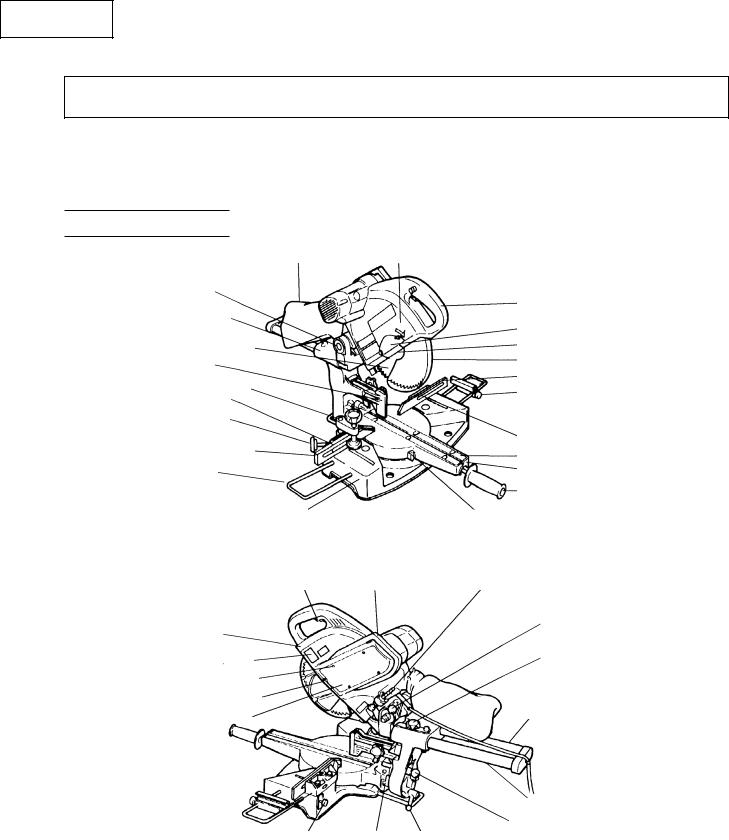
English
OPERATION AND MAINTENANCE
NOTE: The information contained in this Instruction Manual is designed to assist you in the safe operation and maintenance of the power tool. Some illustrations in this Instruction Manual may show details or attachments that differ from those on your own power tool.
NAME OF PARTS
Head
Dust Bag
Hinge
Holder (A)
TCT Saw Blade
Guard
Vise Assembly
Fence (B) 10mm Knob Bolt
Slide Fence (B)
Holder (Optional Accessory)
Base
Side Cover (L)
Handle
Spindle Cover
Washer (C), Bolt
Safety Cover
Fence (A)
Stopper
(Optional Accessory)
Slide Fence (A)
Table Insert
Turntable
Side Handle
Indicator
Fig. 1
|
|
|
|
|
Trigger Switch Carrying Handle |
8 mm Depth Adjustment Bolt |
||||
|
|
|
|
|
|
|
|
|
|
|
|
|
|
|
|
Locking |
|
Pin |
|||
Side |
Cover (R) |
|
|
|
||||||
|
|
|
|
|
|
|
|
|
|
|
|
|
|
|
|
|
|
|
|
|
|
|
|
|
|
|
|
|
|
|
|
|
Nameplate |
|
|
|
|
|
Slide |
Securing Knob |
|||
5mm Screw |
|
|
|
|
||||||
|
|
|
|
|
|
|
||||
|
|
|
|
|||||||
Spindle Lock |
|
|
Slide Pipe (B) |
|||||||
|
|
|
|
|
|
|
|
|||
Belt |
Cover |
|
|
|
|
|
||||
|
|
|
|
|
||||||
Slide Pipe (A)
Fixing Pin
6mm Knob Bolt |
Indicator Clamp Lever |
(Optional Accessory) |
|
Fig. 2
8

English
SPECIFICATIONS
Item |
Model |
C 10FS |
|
Motor |
Type |
Series commutator motor |
|
|
|
Power source |
Single-phase AC 60Hz |
|
|
|
|
|
|
Voltage (Volts) |
115 |
|
|
|
|
|
|
Full-load current (Amp) |
12 |
|
|
|
|
Applicable |
|
Outside Dia. 10" (255mm) |
|
saw blade |
|
Hole Dia. 5/8" (15.9mm) |
|
No load speed |
|
3800 rpm |
|
Max. |
|
Head |
Turntable |
Max. sawing dimension |
||
sawing |
Miter |
0 |
0 |
Max. Height |
3-11/32" ( 85mm) |
|
dimension |
|
|
* |
Max. Width |
12-9/32" |
(312mm) |
|
|
|
Max. Width |
11-59/64" (303mm) |
||
|
|
|
|
or |
|
|
|
|
|
*1 |
Max. Height |
3-35/64" ( 90mm) |
|
|
|
|
|
Max. Width |
11-39/64" (295mm) |
|
|
|
|
* |
Max. Width |
11-1/4" |
(286mm) |
|
|
0 |
Left 45° |
Max. Height |
3-11/32" ( 85mm) |
|
|
|
|
|
Max. Width |
8-21/32" (220mm) |
|
|
|
|
* |
Max. Width |
8-19/64" (211mm) |
|
|
|
|
|
or |
|
|
|
|
|
*1 |
Max. Height |
3-35/64" ( 90mm) |
|
|
|
|
|
Max. Width |
8-15/32" (215mm) |
|
|
|
|
* |
Max. Width |
8-7/64" |
(206mm) |
|
|
0 |
Right 45° |
Max. Height |
3-11/32" ( 85mm) |
|
|
|
|
|
Max. Width |
8-21/32" (220mm) |
|
|
|
|
* |
Max. Width |
8-19/64" (211mm) |
|
|
|
|
|
or |
|
|
|
|
|
*1 |
Max. Height |
3-35/64" ( 90mm) |
|
|
|
|
|
Max. Width |
8-15/32" (215mm) |
|
|
|
|
* |
Max. Width |
8-7/64" |
(206mm) |
|
Bevel |
Left 45° |
0 |
Max. Height |
2-11/64" ( 55mm) |
|
|
|
|
|
Max. Width |
12" |
(305mm) |
|
|
|
* |
Max. Width |
11-21/32" (296mm) |
|
|
|
|
|
or |
|
|
|
|
|
*1 |
Max. Height |
2-3/8" |
( 60mm) |
|
|
|
|
Max. Width |
11-39/64" (295mm) |
|
|
|
|
* |
Max. Width |
11-1/4" |
(286mm) |
|
|
Rigth 45° |
0 |
Max. Height |
1-3/16" |
( 30mm) |
|
|
|
|
Max. Width |
12" |
(305mm) |
|
|
|
* |
Max. Width |
11-21/32" (296mm) |
|
|
|
|
|
or |
|
|
|
|
|
*1 |
Max. Height |
1-3/8" |
( 35mm) |
|
|
|
|
Max. Width |
11-39/64" (295mm) |
|
|
|
|
* |
Max. Width |
11-1/4" |
(286mm) |
|
Compound |
Left 45° |
Left 45° |
Max. Height |
2-11/64" ( 55mm) |
|
|
|
|
or Right 45° |
Max. Width |
8-21/32" (220mm) |
|
|
|
|
* |
Max. Width |
8-19/64" (211mm) |
|
|
|
|
|
or |
|
|
|
|
|
*1 |
Max. Height |
2-3/8" |
( 60mm) |
|
|
|
|
Max. Width |
8-15/32" (215mm) |
|
|
|
|
* |
Max. Width |
8-7/64" |
(206mm) |
|
|
Right 45° |
Left 31° |
Max. Height |
1-3/16" |
( 30mm) |
|
|
|
|
Max. Width |
10" |
(255mm) |
|
|
|
* |
Max. Width |
9-11/16" (246mm) |
|
|
|
|
|
or |
|
|
|
|
|
*1 |
Max. Height |
1-3/8" |
( 35mm) |
|
|
|
|
Max. Width |
9-27/32" (250mm) |
|
|
|
|
* |
Max. Width |
9-31/64" (241mm) |
|
|
|
Right 45° |
Right 45° |
Max. Height |
1-3/16" |
( 30mm) |
|
|
|
|
Max. Width |
8-21/32" (220mm) |
|
|
|
|
* |
Max. Width |
8-19/64" (211mm) |
|
|
|
|
|
or |
|
|
|
|
|
*1 |
Max. Height |
1-3/8" |
( 35mm) |
|
|
|
|
Max. Width |
8-15/32" (215mm) |
|
|
|
|
* |
Max. Width |
8-7/64" |
(206mm) |
9
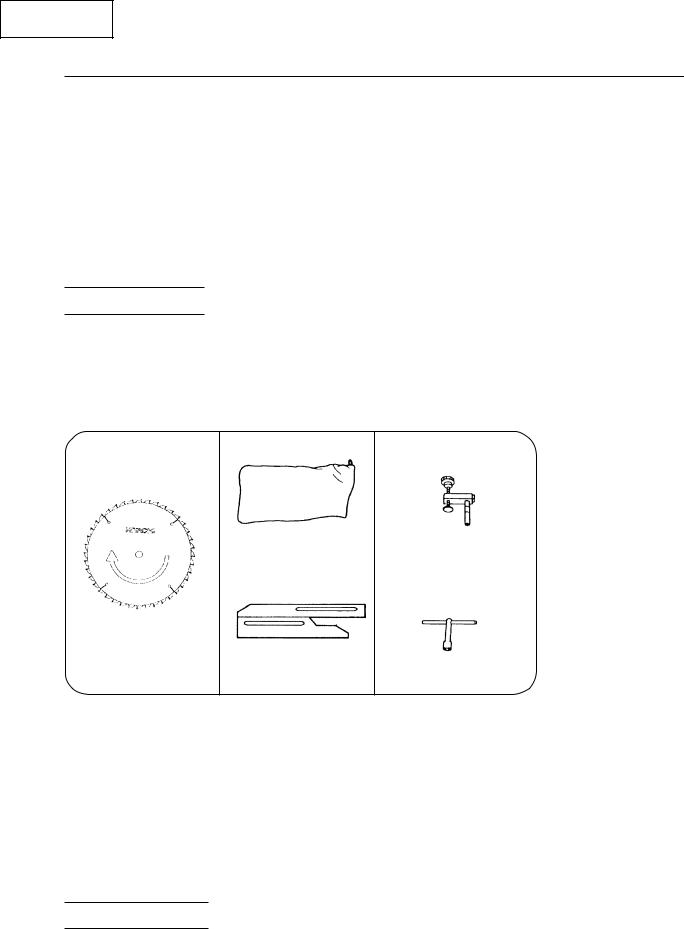
English
Miter sawing range |
Left 0° – 45° Right 0° – 45° |
Bevel sawing range |
Left 0° – 45° Right 0° – 45° |
|
|
Compound sawing range |
Left (Bevel) 0° – 45°, Left and Right (Miter) 0° – 45° |
|
Right (Bevel) 0° – 45°, Left (Miter) 0° – 31°, Right (Miter) 0° – 45° |
Net weight |
44lbs. (20kg) |
|
|
Cord |
2 Conductor type cable 6.5ft. (1.99m) |
|
|
*When slide fence assembly is used.
When cutting the workpiece which has the dimension of “*1” there might be some possibility of the lower end of the circular saw to touch with the workpiece, even if the motor head is located at the lower limit position. Pay attention when cutting the workpiece. For further details, refer to “PRACTICAL APPLICATIONS” on page 15.
ACCESSORIES
 WARNING: Accessories for this power tool are mentioned in this Instruction Manual.
WARNING: Accessories for this power tool are mentioned in this Instruction Manual.
The use of any other attachment or accessory can be dangerous and could cause injury or mechanical damage.
STANDARD ACCESSORIES
q10" (255mm) TCT Saw blade (1 piece)
(No. of teeth 40 Code No. 310878A)
w Dust bag (1 piece) |
r Vise Assembly w/knob |
|
bolt (1 piece) |
For how to use, refer to |
For how to use, refer to page |
|
page 23. |
||
16. |
||
|
||
|
|
|
e Slide Fence Assembly |
t 10mm BOX |
|
|
wrench (1 piece) |
For how to use, refer to page 16.
Fig. 3
OPTIONAL ACCESSORIES...sold separately
q Extension Holder and Stopper (Fig. 1) (Code No. 998866)
w Saw blade 10" (255mm) TCT Saw blade (Total teeth: 72) (Code No. 725206)
e Vise (A) Assembly (Code No. 308394)
NOTE: Accessories are subject to change without any obligation on the part of the HITACHI.
APPLICATIONS
Wood and aluminum sash.
10
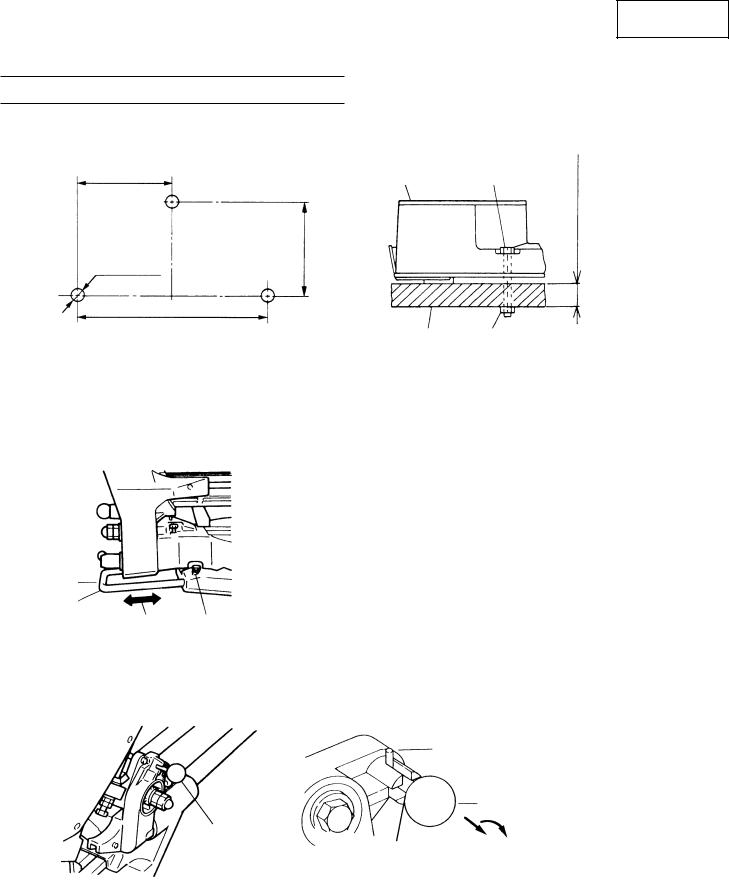
PREPARATION BEFORE OPERATION
Make the following preparations before operating the power tool:
1. Installation
5-29/32" (150mm) |
Base |
5/16" (8mm) Bolt |
|
||
|
(264mm) |
|
|
13/32"-10 |
|
11/32" (9mm) 3 Holes
11-13/16" (300mm)
English
1" (25mm) thick bench
Work Bench 5/16" (8mm) Nut
Fig. 4
Attach the power tool to a level, horizontal work bench in accordance with Fig. 4.
Select 5/16" (8mm) diameter bolts suitable in length for the thickness of the work bench. Bolt length should be at least 1" (25mm) plus the thickness of the work bench.
For example, use 2" (50mm) or larger bolts for a 1" (25mm) thick work bench. The holder attached to the rear of the base helps stabilize the power tool.
Base holder adjustment:
Loosen the 6mm bolt with the supplied 10mm box wrench. Adjust the base holder until its bottom surface contacts the work bench surface.
After adjustment, firmly tighten the 6mm bolt.
Base Holder |
|
|
|
Adjust the base |
|
|
|
holder until its |
Move |
6mm Bolt |
|
bottom surface |
|||
|
|
||
contacts the work |
|
|
|
bench surface. |
|
|
|
|
Fig. 5 |
|
2. Releasing the locking pin
During transport, fit the pin into the deep slot.
NOTE: This position is not be used for any cutting operation.
Locking Pin
During operation fit the pin stoppers into the shallow slot.
Locking Pin
Clockwise
Pull out to disengage. Rotate the knob 1/4 turn and fit the pin stoppers into the shallow slot.
Fig. 6-a |
Fig. 6-b |
When the power tool is prepared for shipping, its main parts are secured by a locking pin.
Move the handle (see Fig. 1) slightly so that the locking pin can be disengaged and adjusted as indicated in Fig. 6-b.
NOTE: Lowering the handle (see Fig. 1) slightly will enable you to disengage the locking pin more easily and safely.
The lock position of the locking pin is for carrying and storage only.
11
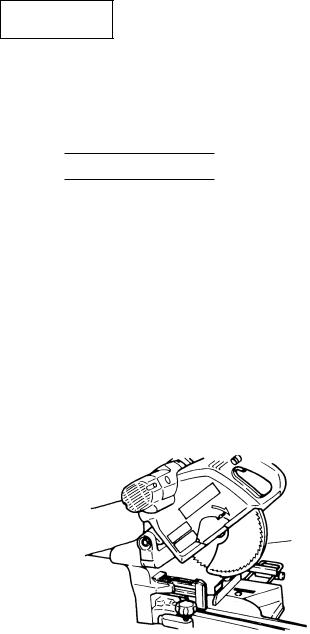
English
3. Installing the dust bag, holder, stopper and vises.
(The holder and stopper are optional accessories).
Attach the dust bag, holder, stopper and vise assembly, slide fence (A) and slide fence (B) as indicated in Fig. 1.
BEFORE USING
1. Make sure the power source is appropriate for the tool.
 WARNING: Never connect the power tool unless the available AC power source is of the same voltage as that specified on the nameplate of the tool.
WARNING: Never connect the power tool unless the available AC power source is of the same voltage as that specified on the nameplate of the tool.
Never connect this power tool to a DC power source.
2. Make sure the trigger switch is turned OFF.
 WARNING: If the power cord is connected to the power source with the trigger switch turned ON the power tool will start suddenly and can cause a serious accident.
WARNING: If the power cord is connected to the power source with the trigger switch turned ON the power tool will start suddenly and can cause a serious accident.
3. Check the saw blade for visible defects.
Confirm that the saw blade is free of cracks or other visible damage.
4. Confirm that the saw blade is attached securely to the power tool.
Using the supplied 10mm box wrench, tighten the bolt on the saw blade spindle to secure the saw blade. For details, see Fig. 42-a and Fig. 42-b in the section on “SAW BLADE MOUNTING AND DISMOUNTING”.
5. Check the safety cover for proper operation.
Safety cover is designed to protect the operator from coming into contact with the saw blade during operation of the tool.
Always check that the safety cover moves smoothly and covers the saw blade properly.
Safety Cover
Fig. 7
 WARNING: NEVER OPERATE THE POWER TOOL if the safety cover does not function smoothly.
WARNING: NEVER OPERATE THE POWER TOOL if the safety cover does not function smoothly.
6. Confirm the position of the spindle lock before using the tool.
After installing the saw blade, confirm that the spindle lock has been returned to the retract position before using the power tool (see Fig. 2).
7. Check the lower limit position of the Saw Blade.
Although it was adjusted before shipment, carefully check the height of the saw blade. Confirm that the saw blade can be lowered 13/32" to 27/64" (10mm to 11mm) below the table insert. For details, see the section on “Checking the saw blade lower limit position”.
8. Check the Power Receptacle.
To prevent overheating, accidental stopping or intermittent operation, confirm that the power cord plug fits properly in the electrical receptacle and does not fall out after it is inserted. Repair or replace the receptacle if it is faulty.
9. Confirm the tool’s power cord is not damaged.
Repair or replace the power cord if an inspection indicates that it is damaged.
AFTER CONNECTING THE POWER PLUG TO AN APPROPRIATE AC POWER SOURCE, CHECK THE OPERATION OF THE TOOL AS FOLLOWS:
10. Trial Run
After confirming that no one is standing behind, the power tool start and confirm that no operating abnormalities exist before attempting a cutting operation.
12
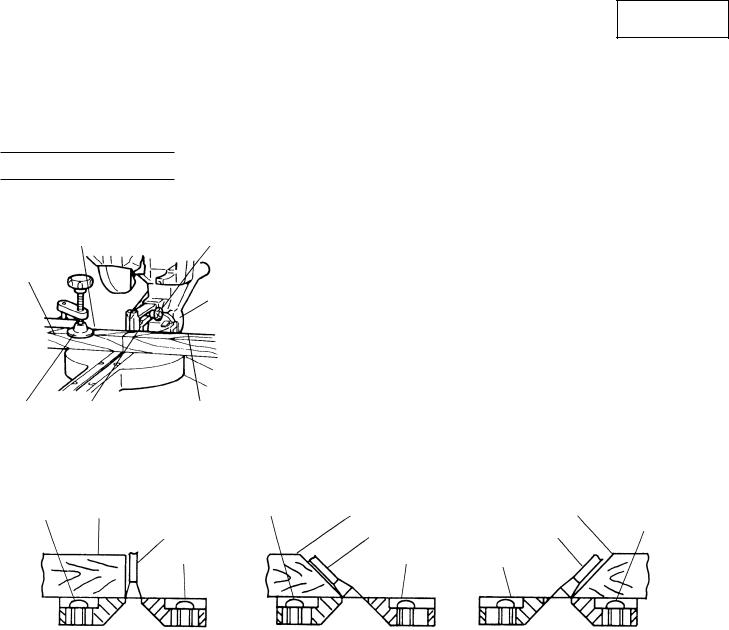
English
11. Inspect the rotating stability of the saw blade.
For precise cutting, rotate the saw blade and check for deflection to confirm that the blade is not noticeably unstable; otherwise vibrations might occur and cause an accident.
BEFORE CUTTING
1. Cutting a groove on the guard
Fence (B) |
8mm Knob Bolt |
Workpiece
Holder
(A)
Holder (A) has a guard (see Fig. 8) into which a groove must be cut. Loosen the 8mm knob bolt to retract the guard slightly. After placing a suitable wooden piece to sit on the fence and the table surfaces, fix it with the vise assembly.
After the switch has been turned on and the saw blade has reached maximum speed, slowly lower the handle to cut a groove on the guard.
 CAUTION: Do not cut the groove too quickly; otherwise the guard might become damaged.
CAUTION: Do not cut the groove too quickly; otherwise the guard might become damaged.
Vise Assembly |
Guard |
Fence (A) |
|
|
Fig. 8 |
2. Positioning the table insert
6mm |
|
|
|
|
|
|
6mm |
|
|
|
|
|
|
|
|
6mm |
|
|
|
|
|
|
|
|
|
|
|
|
|
|
|||
Machine |
Workpiece |
|
|
|
|
Machine |
|
Workpiece |
|
|
|
|
Workpiece |
Machine |
||
Screw |
|
|
Saw |
Blade |
Screw |
|
Saw |
Blade |
|
|
|
|
Saw Blade |
Screw |
||
|
|
|
|
|
|
|||||||||||
|
|
|
|
|
|
|
|
|
|
|||||||
|
|
|
|
Table |
insert |
|
Table |
insert |
Table |
insert |
|
|||||
[Right angle cutting] |
[Left bevel angle cutting] |
[Right bevel angle cutting] |
Fig. 9-a |
Fig. 9-b |
Fig. 9-c |
Table inserts are installed on the turntable. When shipping the tool from the factory, the table inserts are so fixed that the saw blade does not contact them. The burr of the bottom surface of the workpiece is remarkably reduced, if the table insert is fixed so that the gap between the side surface of the table insert and the saw blade will be minimum. Before using the tool, eliminate this gap in accordance with the following procedure.
(1)Right angle cutting
Loosen the three 6mm machine screws, then secure the left side table insert and temporarily tighten the 6mm machine screws of both ends. Then fix a workpiece (about 7-7/8" (200mm) wide) with the vise assembly and cut it off. After aligning the cutting surface with the edge of the table insert, securely tighten the 6mm machine screws of both ends. Remove the workpiece and securely tighten the 6mm center machine screw. Adjust the right hand table insert in the same way.
(2)Left and right bevel angle cutting
Adjust the table insert in the manner shown in Fig. 9 following the same procedure for right angle cutting.
 CAUTION: After adjusting the table insert for right angle cutting, the table insert will be cut to some extent if it is used for bevel angle cutting.
CAUTION: After adjusting the table insert for right angle cutting, the table insert will be cut to some extent if it is used for bevel angle cutting.
When bevel cutting operation is required, adjust the table insert for bevel angle cutting.
13
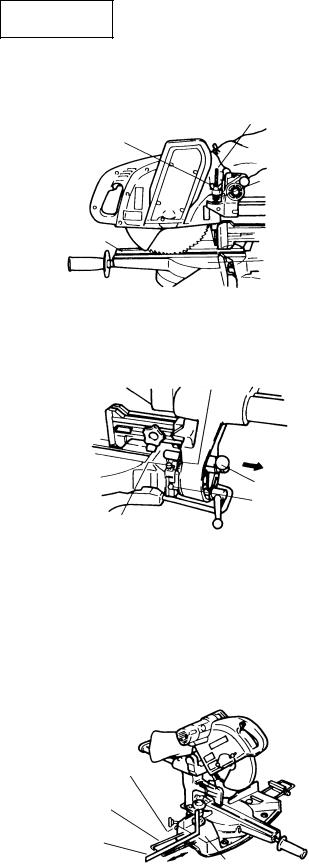
English
3. Checking the saw blade lower limit position
8mm Depth Adjustment
Bolt
8mm Wing Nut
8mm Nut (2 pieces)
Table Insert
Turntable
Fig. 10
Check that the saw blade can be lowered 13/32" to 27/64" (10mm to 11mm) below the table insert.
If necessary, adjust as follows:
(1)Loosen the 8mm wing nut and the two 8mm nuts on the 8mm depth adjustment bolt.
(2)Turn the 8mm depth adjustment bolt as necessary to set the lower limit position.
(3)Once the adjustment is complete, fully tighten the two 8mm nuts and the 8mm wing nut.
NOTE: Before tightening the two 8mm nuts and the 8mm wing nut, confirm that the saw blade is adjusted so that it will not cut into the turntable.
4. Oblique angle
6mm Bolt (A) (Stopper for 0°)
Fixing Pin
Indicator
6mm Bolt (C) (Stopper for right 45° bevel angle)
Fig. 11
Before the power tool is shipped from the factory, it is adjusted for 0°, right angle, left 45° bevel cutting angle and right 45° bevel cutting angle with the 6mm bolt (A), 6mm bolt (C) and the 8mm bolt (B). When changing the adjustment, change the height of the 6mm bolt (A), 6mm bolt (C) or the 8mm bolt (B) by turning them.
When changing the bevel angle to the right 45°, pull the fixing pin on the direction shown in Fig. 11 and incline the motor head to the right.
When adjusting the motor head to 0°, always return the fixing pin to its initial position.
5.Securing the workpiece
 WARNING: Always clamp or vise to secure the workpiece to the fence; otherwise the workpiece
WARNING: Always clamp or vise to secure the workpiece to the fence; otherwise the workpiece
might be thrust from the table and cause bodily harm.
6. Installing the holders ... (Optional accessory)
6mm Knob Bolt (Optional Accessory)
Holder
Steel
Square
The holders help keep longer workpieces stable and in place during the cutting operation.
(1)As indicated in Fig. 12, use a steel square for aligning the upper edge of the holders with the base surface.
(2)After aligning, secure the holders with the 6mm knob bolts (Optional accessory).
Base Surface
Fig. 12
14
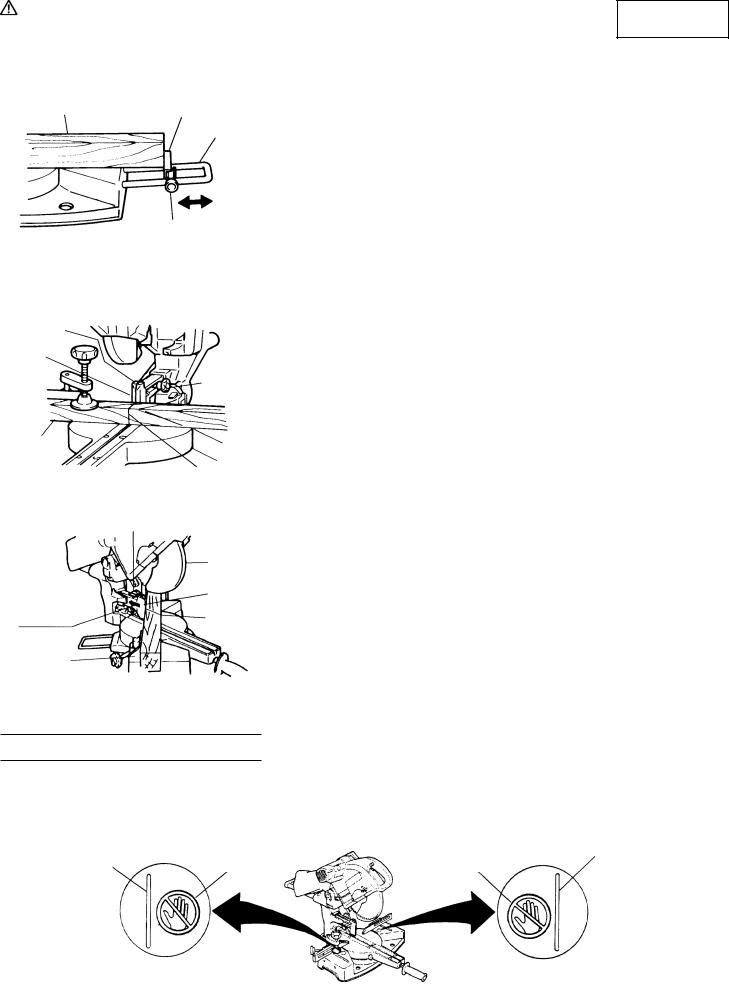
English
7. Stopper for precision cutting ... (Stopper is optional accessory)
Workpiece |
Stopper |
Holder
The stopper facilitates continuous precision cutting in lengths of 10-7/16" to 16-15/16" (265mm to 430mm).
To install the stopper, attach it to the holder with the 6mm knob bolt as shown in Fig. 13.
|
|
|
|
6mm Knob Bolt |
|
|
||
|
|
|
|
Fig. 13 |
|
|
||
8. Using an ink line |
|
|
||||||
Saw Blade |
|
|
|
|
(1) Right angle cutting |
|||
|
|
|
|
|
Loosen the 8mm knob bolt and contact the tip of the guard |
|||
Groove |
|
|
|
|
|
|||
Guard |
|
|
|
|
with the workpiece. |
|||
|
|
|
|
Aligning the ink line on the workpiece with the groove of the |
||||
|
|
|
|
|
|
|
|
|
|
|
|
|
|
|
8mm |
|
guard, the workpiece is cut on the ink line (Fig. 14). |
|
|
|
|
|
|
|
||
Workpiece |
|
|
Knob Bolt |
|
|
|||
|
|
|
|
|||||
|
|
|
|
|
||||
|
|
|
|
|
Marking |
|
|
|
|
|
|
|
|
(pre-marked) |
|
||
|
|
|
|
Fig. 14 |
|
|
||
|
|
|
|
8mm Knob Bolt |
(2) Miter cutting and compound cutting |
|||
|
|
|
|
|
|
|
|
(Miter cutting + bevel cutting) |
|
|
|
|
|
|
Safety |
|
Upon lowering the motor section, the safety cover is raised and |
|
|
|
|
|
|
Cover |
|
the saw blade appears. |
|
|
|
|
|
|
|
|
|
|
|
Move the |
|
|
Guard |
|
Align the ink line with the saw blade (Fig. 15). |
|
|
|
|
|
|
CAUTION: In some arrangements when the turntable is |
|||
|
|
Guard |
|
|
Marking |
|
||
|
|
|
|
|
|
|
||
|
|
Backward |
|
|
(pre-marekd) |
rotated, the guard projects from the fence sur- |
||
|
|
|
|
|||||
|
|
|
|
|
|
|||
face. Loosen the 8mm knob bolt and push the
Fence (B)
guard to the retracted position. Never lift the safety cover while the saw blade is rotating.
Fig. 15
PRACTICAL APPLICATIONS
 WARNING: * To avoid personal injury, never remove or place a workpiece on the table while the tool is being operated.
WARNING: * To avoid personal injury, never remove or place a workpiece on the table while the tool is being operated.
*Never place your limbs inside of the line next to warning sign while the tool is being operated. This may cause hazardous conditions (see Fig. 16).
|
|
|
|
|
|
|
|
Line |
Warning Sign |
Warning Sign |
Line |
Fig. 16
15

English
1. Switch operation
Lock-off Button
Handle
Hole
Trigger
Switch
Fig. 17
The trigger switch lock-off button is designed to prevent inadvertent operation of the power tool.To operate the power tool, it is necessary to first fully insert the lock-off button into the hole on the handle as shown in Fig. 17.
The trigger switch will not operate unless the lock-off button has been pushed in.
When the trigger switch is released, the power goes off and the lock-off button automatically returns to its initial position, locking the trigger switch.
 WARNING: Always remove the lock-off button from the handle when the power tool is not in use. This will ensure that the power tool cannot be turned on accidentally or by someone (especially a child) who is not qualified to use the power tool. If the lock-off button is left in the handle, serious personal injury can result. Since the lock-off button fits rather tightly, it may be necessary to turn it to the left and right during mounting and removing.
WARNING: Always remove the lock-off button from the handle when the power tool is not in use. This will ensure that the power tool cannot be turned on accidentally or by someone (especially a child) who is not qualified to use the power tool. If the lock-off button is left in the handle, serious personal injury can result. Since the lock-off button fits rather tightly, it may be necessary to turn it to the left and right during mounting and removing.
2. Using the Vise Assembly (Standard accessory)
Knob
Screw Holder
|
Vise Shaft |
|
|
||||
|
|
|
|
|
|
|
|
|
Alignment |
|
|||||
|
Groove |
Vise |
|||||
|
|
|
|
|
|
|
|
|
Groove |
|
Plate |
||||
|
|
|
|||||
|
|
Fence |
|
Work- |
|||
|
|
|
|
|
|
|
|
|
|
|
|
|
|
|
piece |
|
|
10mm Knob |
|
||||
|
|
Bolt |
|
||||
|
|
|
|
|
|
|
Fig. 18 |
The vise assembly can be mounted on either the left fence {Fence (B)} or the right fence {Fence (A)}, and can be raised or lowered according to the height of the workpiece.
To raise or lower the vise assembly, first loosen the 10mm knob bolt. As shown in Fig. 18, the vise shaft has four locking grooves into which the tip of the 10mm knob bolt is designed to fit in order to lock the screw holder in the desired position.
To ensure that the tip of the 10mm knob bolt is properly aligned with the desired locking groove on the vise shaft, simply align the upper surface of the fence to either of three grooves on the vise shaft surface or to the lower surface of the screw holder.
Therefore, the vise assembly can be attached in either of four positions to ensure proper height adjustment.
After adjusting the height, firmly tighten the 10mm knob bolt; then turn the upper knob, as necessary, to securely attach the workpiece in position.
 CAUTION: Always confirm that the motor head (see Fig. 1) does not contact the vise assembly when it is lowered for cutting. If there is any danger that it may do so, loosen the 10mm knob bolt slightly and move the vise to a position where it will not contact the saw blade.
CAUTION: Always confirm that the motor head (see Fig. 1) does not contact the vise assembly when it is lowered for cutting. If there is any danger that it may do so, loosen the 10mm knob bolt slightly and move the vise to a position where it will not contact the saw blade.
Also, always confirm that the vise assembly is mounted on the right side {Fence (A)} before using the saw for compound cutting operations (miter + bevel cutting).
3. Using the Slide Fence (A) and Slide Fence (B) (Standard accessory)
2-4/3" (70mm) |
2-5/32" (55mm) |
Fence (B) |
Fence (A) |
Slide Fence (B) |
|
Slide fence (A) and slide fence (B) are meant to stabilize small workpieces as shown in Fig. 19.
Slide Fence (A)
Workpiece
Cut off side piece
Clearance between fence (A) and fence (B) and the workpiece is necessary. The edge of workpiece should not overlap with fence (A) and fence (B).
Fig. 19
16
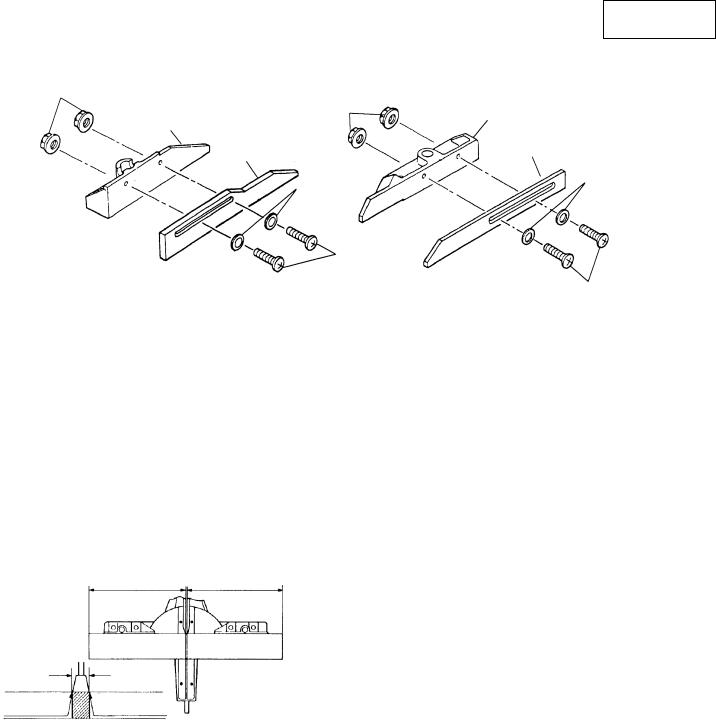
English
Flange Nut
Flange Nut |
Fence (A) |
Fence (B) |
|
Slide Fence (B) |
Slide Fence (A) |
|
Nylon Washer
Nylon Washer
Machine Screw
Machine Screw
Fig. 20
(1)Set slide fence (A) and slide fence (B) on fence (A) and fence (B) of the base.
(2)To attach use the four machine screws with nylon washers and flange nuts as shown in Fig. 20.
(3)Adjust slide fence (A) and slide fence (B) to stabilize the workpiece. Adjustable range of slide fence
(A) and slide fence (B) is from 0 to 3-1/32" (0 to 77mm)).
(4)Confirm the position of slide fence (A) and slide fence (B) on fence (A) and fence (B) with four machine screws tightly so slide fence (A) and slide fence (B) do not move (see Fig. 20).
 CAUTION: * Before operation, ensure that the saw blade does not contact slide fence (A) and slide fence (B). In case the saw blade contacts slide fence (A) and slide fence (B), adjust the position of slide fence (A) and slide fence (B) again.
CAUTION: * Before operation, ensure that the saw blade does not contact slide fence (A) and slide fence (B). In case the saw blade contacts slide fence (A) and slide fence (B), adjust the position of slide fence (A) and slide fence (B) again.
*Maximum cross-cutting width (Bevel 0°, Miter 0°) is 11-59/64" (303mm).
4.Cutting Operation
a Adjusting Line b
|
a |
b |
Marking |
a |
b Marking |
(pre-marked) |
(pre-marked) |
|
(Front View)
Fig. 21
(1)As shown in Fig. 21 the width of the saw blade is the width of the cut. Therefore, slide the workpiece to the
right (viewed from the operator’s position) when length b is desired, or to the left when length a is desired.
(2)Once the saw blade reaches maximum speed, push the handle down carefully until the saw blade approaches the workpiece.
(3)Once the saw blade contacts the workpiece, push the handle down gradually to cut into the workpiece.
(4)After cutting the workpiece to the desired depth, turn the power tool OFF and let the saw blade stop completely before raising the handle from the workpiece to return it to the full retract position.
 CAUTION: * Increased pressure on the handle will not increase the cutting speed.
CAUTION: * Increased pressure on the handle will not increase the cutting speed.
On the contrary, too much pressure may result in overload of the motor and/or decreased cutting efficiency.
 WARNING: * Confirm that the trigger switch is turned OFF and the power plug has been removed from the receptacle whenever the tool is not in use.
WARNING: * Confirm that the trigger switch is turned OFF and the power plug has been removed from the receptacle whenever the tool is not in use.
*Always remove the lock-off button from the handle and store it in a secure place after completing the work.
17
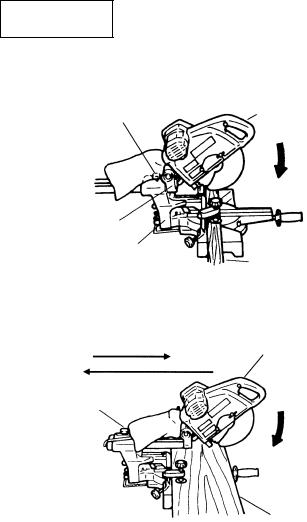
English
5. Cutting narrow workpieces (Press cutting)
Handle
Slide Securing Knob
Press
Down
Hinge
Holder (A)
Workpiece
Fig. 22
Slide the hinge down to holder (A), then tighten the slide securing knob as indicated in Fig. 22.
Lower the handle to cut the workpiece.
Using the power tool this way will permit cutting of workpieces of up to 3-11/32" (85mm) square.
6. Cutting wide workpieces (Slide cutting)
q Pull Forward |
Handle |
e Push Rearward to Cut |
|
Slide securing |
w Pess |
knob |
Down |
Workpiece
(1)Workpieces up to 3-11/32" (85mm) high and 12-9/32" (312mm) wide: Loosen the slide securing knob, grip the handle and slide the saw blade forward.
Then press down on the handle and slide the saw blade back to cut the workpiece as indicated in Fig. 23. This facilitates cutting of workpieces of up to 3-11/32" (85mm) in height and 12-9/32" (312mm) in width.
(2)Workpieces up to 3-35/64" (90mm) high and 11-39/64" (295mm) wide: Workpieces of up to 3-35/64" (90mm) in height and up to 11-39/64" (295mm) in width can be cut in the same manner as described in paragraph 6-(1) above.
Fig. 23
 CAUTION:
CAUTION:
 WARNING:
WARNING:
*When cutting a workpiece of 3-35/64" (90mm) height, adjust the lower limit position of the motor head so that the gap between the lower edge of the motor head and the workpiece will be 5/64" to 1/8" (2 to 3mm) at the lower limit position.
*If the handle is pressed down with excessive or lateral force, the saw blade may vibrate during the cutting operation and cause unwanted cutting marks on the workpiece, thus reducing the quality of the cut.
Accordingly, press the handle down gently and carefully.
*In slide cutting, gently push the handle back (rearwards) in a single, smooth operation.
Stopping the handle movement during the cut will cause unwanted cutting marks on the workpiece.
*For slide cutting, follow the procedures indicated above in Fig. 23.
Forward slide cutting (toward the operator) is very dangerous because the saw blade could kick upward from the workpiece. Therefore, always slide the handle away from the operator.
*Always return the carriage to the full rear position after each crosscut operation in order to reduce the risk of injury.
*Never put your hand on the side handle during the cutting operation because the saw blade comes close to the side handle when the motor head is lowered.
18
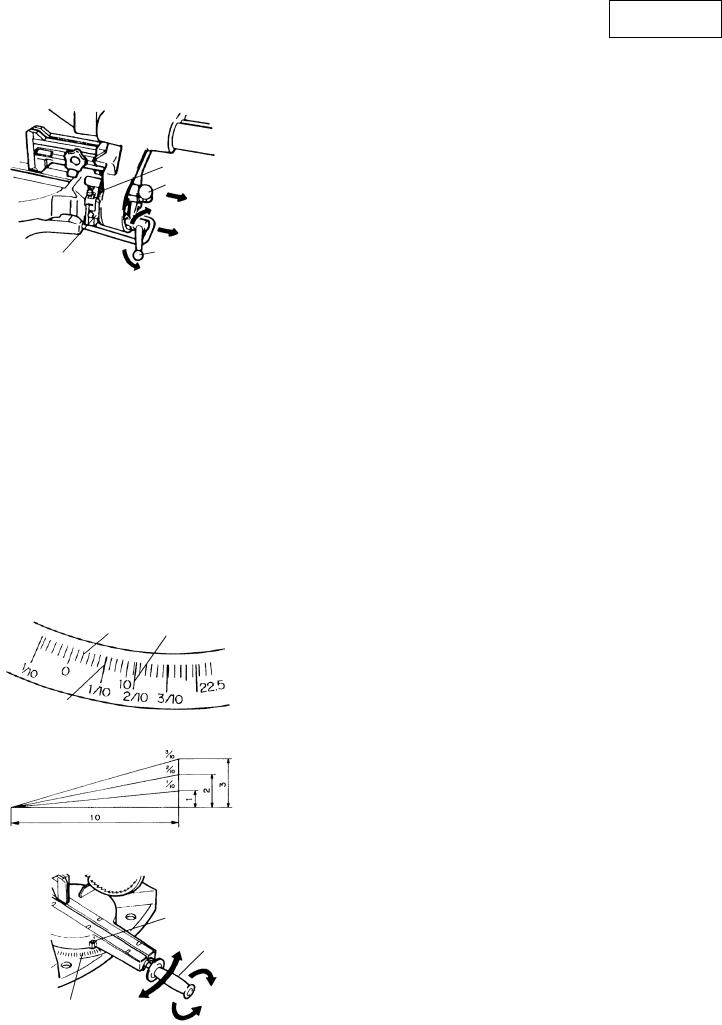
7. Bevel cutting procedures
|
Bevel Angle |
|
Scale |
|
Fixing pin |
|
Loosen |
Indicator |
Clamp Lever |
(Latchet type) |
|
|
Tighten |
Fig. 24
English
(1)Loosen the clamp lever and bevel the saw blade to the left or to the right.
When tilting the motor head to the right pull the fixing pin towards the rear.
(2)Adjust the bevel angle to the desired setting while watching the bevel angle scale and indicator, then secure the clamp lever.
(3)Follow the procedures indicated in paragraphs 5 and 6 above. For maximum dimensions for bevel cutting, refer to “SPECIFICATIONS” table on page 9.
 WARNING: When the workpiece is secured on the left or right side of the blade, the short cut-off portion will come to rest on the right or left side of the saw blade. Always turn the power off and let the saw blade stop completely before raising the handle from the workpiece.
WARNING: When the workpiece is secured on the left or right side of the blade, the short cut-off portion will come to rest on the right or left side of the saw blade. Always turn the power off and let the saw blade stop completely before raising the handle from the workpiece.
If the handle is raised while the saw blade is still rotating, the cut-off piece may become jammed against the saw blade causing fragments to scatter about dangerously.
When stopping the bevel cutting operation halfway, start cutting after pulling back the motor head to the initial position.
Starting from halfway, without pulling back, causes the safety cover to be caught in the cutting groove of the workpiece and to contact the saw blade.
 CAUTION: When cutting a workpiece of 2-3/8" (60mm) height in the left 45° bevel cutting position or a workpiece of 1-3/8" (35mm) height in the right 45° bevel cutting position, adjust the lower limit position of the motor head so that the gap between the lower edge of the motor head and the workpiece will be 5/64" to 1/8" (2 to 3mm) at the lower limit position (refer to “3. Checking the saw blade lower limit position” on page 14).
CAUTION: When cutting a workpiece of 2-3/8" (60mm) height in the left 45° bevel cutting position or a workpiece of 1-3/8" (35mm) height in the right 45° bevel cutting position, adjust the lower limit position of the motor head so that the gap between the lower edge of the motor head and the workpiece will be 5/64" to 1/8" (2 to 3mm) at the lower limit position (refer to “3. Checking the saw blade lower limit position” on page 14).
8. Miter cutting procedures
Angle Scale
a
Grade Scale
Miter Scale
Fig. 25
Fig. 26
Indicator
Side Handle
Tighten
Miter Scale Turn the Loosen
turntable
Fig. 27
(1)Loosen the side handle and adjust the turntable until the indicator aligns with the desired setting on the miter scale (Fig. 27).
(2)Re-tighten the side handle to secure the turntable in the desired position.
(3)The miter scale (Fig. 25) indicates both the cutting angle on the angle scale and the gradient on the grade scale.
(4)The gradient, which is the ratio of the height to the base of the triangular section to be removed, may be used for setting the miter scale instead of the cutting angle, if desired (see Fig. 26).
(5)Therefore, to cut a workpiece at a grade of 2/10, set the indicator to position a as indicated in Fig. 25.
NOTE: * Positive stops are provided at the right and left of the 0° center setting, at 15°, 22.5°, 31.6°, 35.3° and 45° settings.
Check that the miter scale and the tip of the indicator are properly aligned.
*Operation of the saw with the miter scale and indicator out of alignment, or with the side handle not properly tightened, will result in poor cutting precision.
19
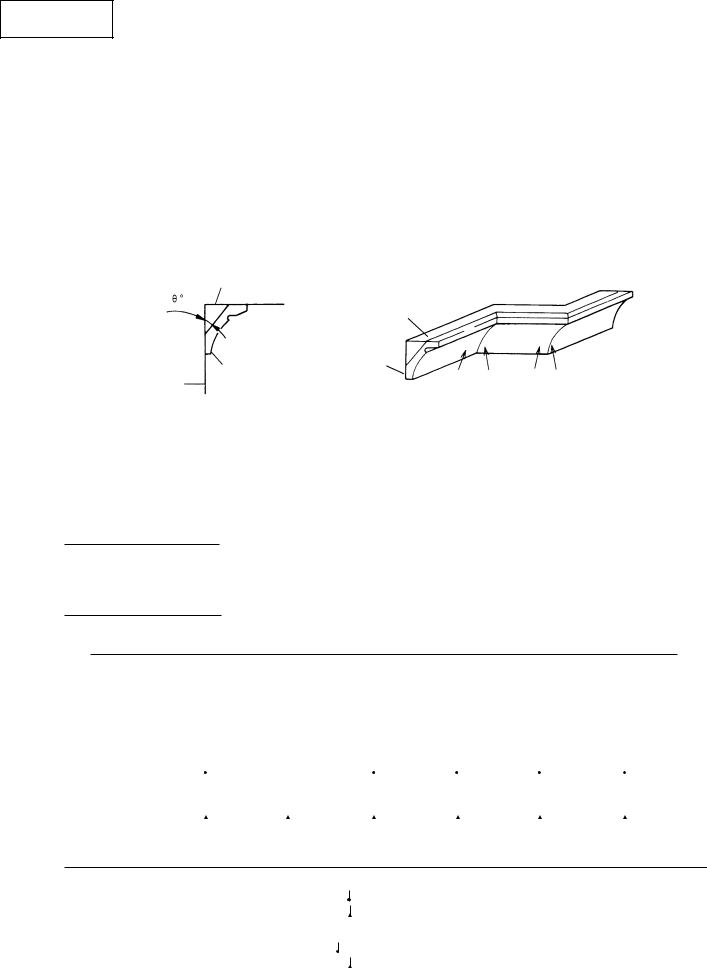
English
9. Compound cutting procedures
Compound cutting can be performed by following the instructions in 7 and 8 above. For maximum dimensions for compound cutting, refer to “SPECIFICATIONS” table on page 9.
 CAUTION: Always secure the workpiece with the right or left hand and cut it by sliding the round portion of the saw backwards with the left hand.
CAUTION: Always secure the workpiece with the right or left hand and cut it by sliding the round portion of the saw backwards with the left hand.
It is very dangerous to rotate the turntable to the left during compound cutting because the saw blade may come into contact with the hand that is securing the workpiece.
10. Crown molding cutting procedures
Fig. 28 shows two common crown molding types having angles of (θ) 38° and 45°. For the typical crown molding fittings, see Fig. 29.
Aupper surface Ceiling
Ceiling
B lower surface |
Wall |
|
q w e r
Wall
Fig. 28 |
Fig. 29 |
The table below shows the miter angle and the bevel angle settings that are ideal for the two crown molding types.
NOTE: For convenience, positive stops are provided for both the miter setting (left and right 31.6°, 35.3°) and the bevel setting positions (left and right 30°, 33.9°).
For miter cut setting
If the turntable has been set to either of the angles described, move the turntable adjusting side handle a little to the right and left to stabilize the position and to properly align the miter angle scale and the tip of the indicator before the operation starts.
For bevel cut setting
Move handle on bevel section to the right and left and check that the position is stable and that the bevel angle scale and the tip of the indicator are properly aligned.Then tighten the clamp lever.
Type of |
To process crown molding at |
|
To process crown molding at |
|
|
||||||||||||||||||||||||
positions 1 and 4 in Fig. 29. |
|
positions 2 and 3 in Fig. 29. |
|
|
|||||||||||||||||||||||||
Crown |
|
|
|
||||||||||||||||||||||||||
|
|
|
|
|
|
|
|
|
|
|
|
|
|
|
|
|
|
|
|
|
|
|
|
|
|
|
|
|
|
|
|
|
|
|
|
|
|
|
|
|
|
|
|
|
|
|
|
|
|
|
|
|
|
|
|
|
|
|
|
Molding |
Miter Angle |
Bevel Angle |
|
|
|
|
|
|
Miter Angle |
Bevel Angle |
|
|
|
|
|
|
|
||||||||||||
|
Setting |
Setting |
|
|
|
|
|
|
Setting |
Setting |
|
|
|
|
|
|
|
||||||||||||
|
|
|
|
|
|
|
|
||||||||||||||||||||||
45° Type |
right 35.3° |
left 30° |
right 30° |
left 35.3° |
left 30° |
right 30° |
|||||||||||||||||||||||
( |
|
|
mark) |
( mark) |
( |
|
|
|
|
mark) |
( |
|
|
mark) |
( |
|
|
|
mark) |
( |
|
|
|
|
mark) |
||||
|
|
|
|
|
|
|
|
|
|||||||||||||||||||||
|
|
|
|
|
|
|
|
|
|
|
|
|
|
|
|
||||||||||||||
38° Type |
right 31.6° |
left 33.9° |
right 33.9° |
left 31.6° |
left 33.9° |
right 33.9° |
|||||||||||||||||||||||
( |
|
|
mark) |
( |
|
mark) |
( |
|
|
|
|
mark) |
( |
|
|
mark) |
( |
|
|
|
mark) |
( |
|
|
|
|
mark) |
||
|
|
|
|
|
|
|
|
|
|||||||||||||||||||||
|
|
|
|
|
|
|
|
|
|
|
|
|
|
|
|
|
|
|
|
|
|
|
|
|
|
|
|
|
|
(1) Setting to cut crown moldings at positions q and r in Fig. 29 (see Fig. 30; tilt the head to the left):
qTurn the turntable to the right and set the Miter Angle as follows:
*For 45°type crown moldings: 35.3° ( mark)
* For 38°type crown moldings: 31.6° ( mark)
wTilt the head to the left and set the Bevel Angle as follows:
*For 45°type crown moldings: 30° ( mark)
* For 38°type crown moldings: 33.9° ( mark)
ePosition the crown molding so that the upper surface (A in Fig. 28) contacts the fence as indicated in Fig. 31.
20
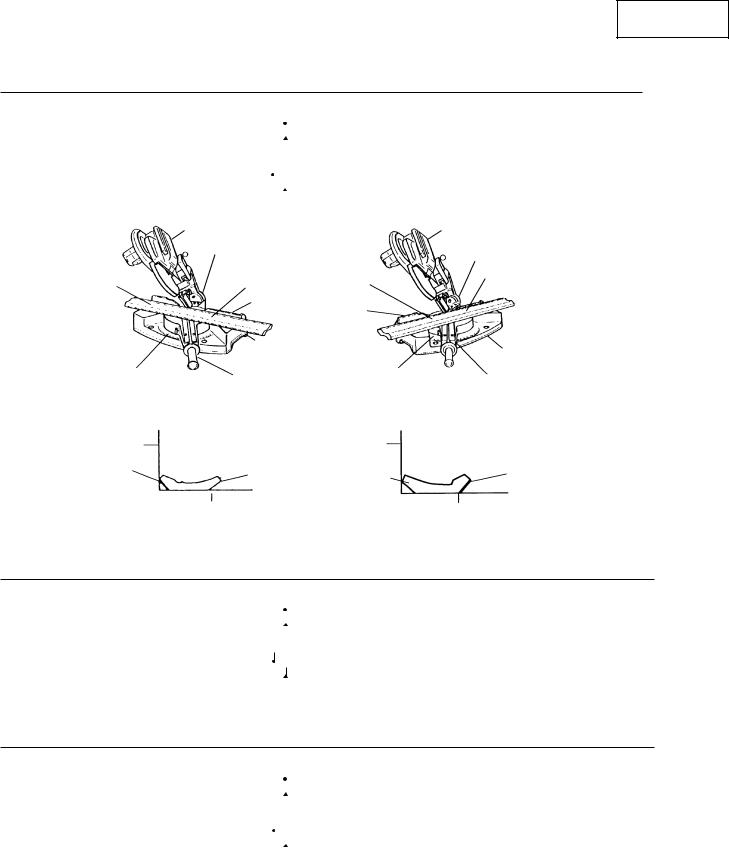
English
(2)Setting to cut crown moldings at positions w and e in Fig. 29 (see Fig. 32; tilt the head to the left): q Turn the turntable to the left and set the Miter Angle as follows:
* For 45°type crown moldings: 35.3° ( |
|
mark) |
* For 38°type crown moldings: 31.6° ( |
|
mark) |
|
w Tilt the head to the left and set the Bevel Angle as follows: |
||||
* For 45°type crown moldings: 30° ( |
|
|
mark) |
|
|
||||
* For 38°type crown moldings: 33.9° ( |
|
mark) |
||
|
||||
e Position the crown molding so that the lower surface (B in Fig. 28) contacts the fence as in Fig. 33.
|
|
Head |
|
|
Head |
|
|
|
|
Bevel Angle Scale |
|
|
Bevel Angle Scale |
||
|
|
|
|
|
|
||
q |
|
|
w |
e |
|||
|
r |
|
|||||
|
|
|
|
|
|
|
|
|
|
|
Fence |
Fence |
|
||
|
|
|
|
|
|||
|
|
|
Base |
|
|
|
Base |
|
|
|
|
|
|
|
|
Miter |
Angle Scale |
|
Turntable |
Miter |
Angle Scale |
Turntable |
|
|
|
Fig. 30 |
|
|
Fig. 32 |
|
|
Fence |
|
|
Fence |
|
|||
|
A |
|
B |
B |
A |
||
|
|
|
|||||
|
|
|
|
|
|||
|
|
Table on Base |
|
|
Table on Base |
||
|
|
Fig. 31 |
|
|
Fig. 33 |
|
|
(3)Setting to cut crown moldings at positions q and r in Fig. 29 (see Fig. 34; tilt the head to the right): q Turn the turntable to the right and set the Miter Angle as follows:
* For 45°type crown moldings: 35.3° ( |
|
mark) |
* For 38°type crown moldings: 31.6° ( |
|
mark) |
|
wTilt the head to the right and set the Bevel Angle as follows:
*For 45°type crown moldings: 30° ( mark)
* For 38°type crown moldings: 33.9° ( mark)
ePosition the crown molding so that the upper surface (B in Fig. 28) contacts the fence as indicated Fig. 35.
(4)Setting to cut crown moldings at positions w and e in Fig. 29 (see Fig. 36; tilt the head to the right): q Turn the turntable to the left and set the Miter Angle as follows:
* For 45°type crown moldings: 35.3° ( |
|
mark) |
* For 38°type crown moldings: 31.6° ( |
|
mark) |
|
w Tilt the head to the right and set the Bevel Angle as follows:
* For 45°type crown moldings: 30° ( |
|
mark) |
|
* For 38°type crown moldings: 33.9° ( |
|
mark) |
|
|
|||
e Position the crown molding so that the lower surface (A in Fig. 28) contacts the fence as in Fig. 37.
21
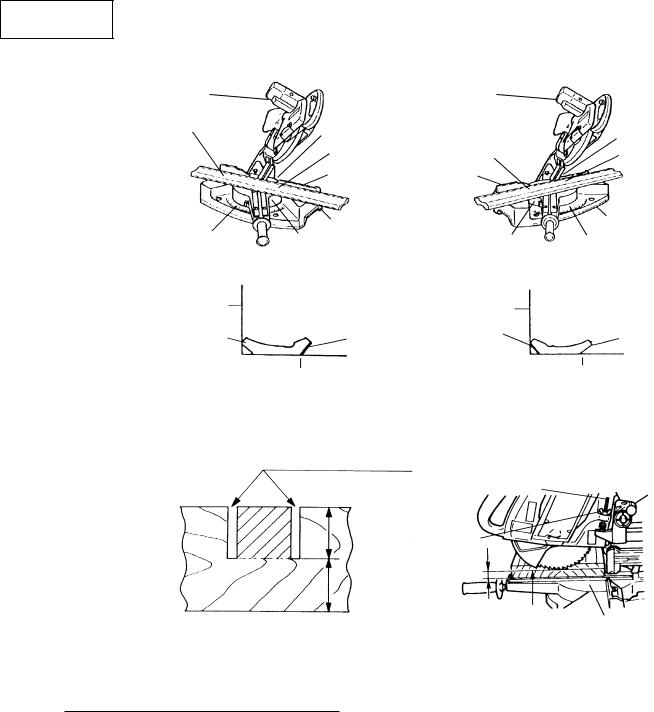
English
Head |
|
Head |
|
r |
Bevel Angle Scale |
|
|
|
|
Bevel Angle Scale |
|
|
|
|
|
|
q |
e |
w |
|
|
|
|
|
Fence |
Fence |
|
|
Base |
|
Base |
Miter Angle |
|
|
|
Turntable |
Turntable |
Miter Angle |
|
Scale |
|
|
Scale |
|
Fig. 34 |
|
Fig. 36 |
Fence |
|
Fence |
|
|
|
|
|
B |
A |
A |
B |
|
|||
|
Table on Base |
|
Table on Base |
|
Fig. 35 |
|
Fig. 37 |
11. Groove cutting procedures |
|
|
|
|
Cut grooves with saw blade |
|
|
|
|
8mm Depth Adjustment Bolt |
|
|
a |
8mm |
|
|
Wing Nut |
|
|
|
|
b |
|
|
b |
|
|
|
|
Bottom Line of |
|
|
|
the Groove |
Turntable |
|
Fig. 38 |
|
Fig. 39 |
Grooves in the workpiece can be cut as indicated in Fig. 38 by adjusting the 8mm depth adjustment bolt.
Cutting depth adjustment procedure:
(1)Loosen the 8mm wing nut and turn the 8mm depth adjustment bolt by hand.
(2)Adjust to the desired cutting depth by setting the distance between the saw blade and the surface of the base (see b in Fig. 38).
(3)The 8mm wing nut must be properly tightened after the adjustment has been completed.
NOTE: When cutting a single groove at either end of the workpiece, remove the unneeded portion with a chisel.
22
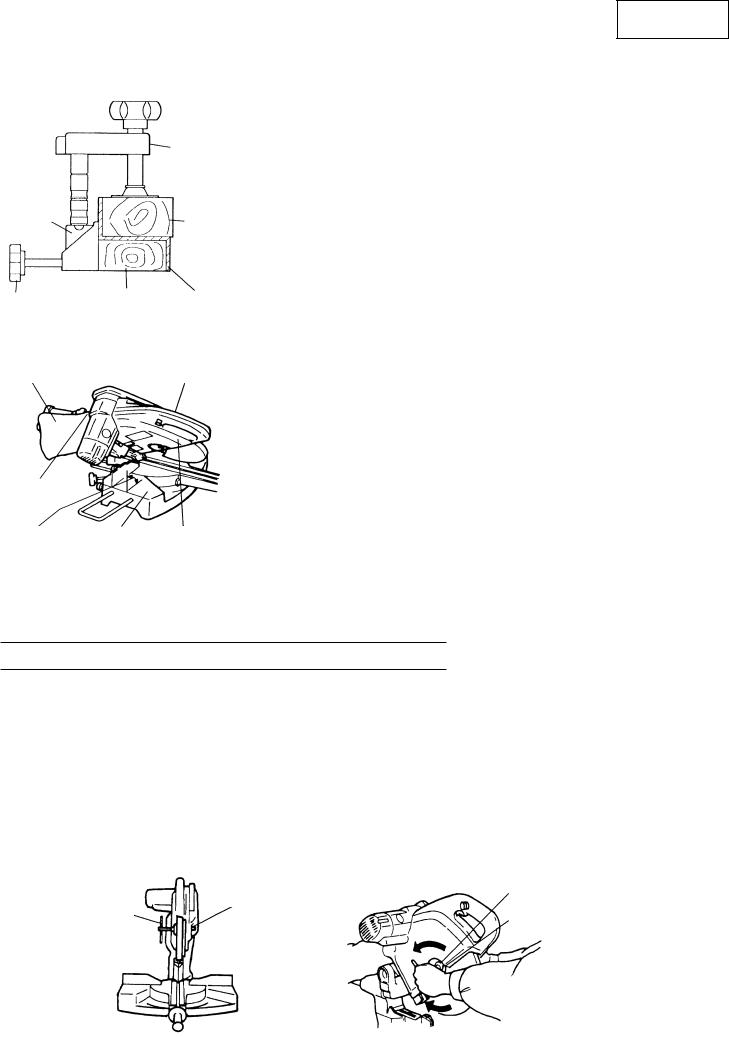
English
12. Cutting easily-deformed materials, such as aluminum sash
Vise assembly
Fence |
Wood plate |
|
10mm Knob Bolt |
Wood plate |
Aluminum sash |
Fig. 40
Materials such as aluminum sash can easily deform when tightened too much in a vise assembly. This will cause inefficient cutting and possible overload of the motor.
When cutting such materials, use a wood plate to protect the workpiece as shown in Fig. 40.
When cutting aluminum materials, coat the saw blade with cutting oil (non-combustible) to achieve smooth cutting and a fine finish.
13. How to use the dust bag (Standard accessory)
Dust Bag |
Side Cover (R) |
Duct
Right Angle Base surface Side Cover (L)
Fig. 41
(1)When the dust bag has become full of sawdust, dust will be blown out of the dust bag when the saw blade rotates.
Check the dust bag periodically and empty it before it becomes full.
(2)During bevel and compound cutting, attach the dust bag at a right angle to the base surface as shown in Fig. 41.
 CAUTION: Empty the dust bag frequently to prevent the duct and the safety cover from becoming clogged.
CAUTION: Empty the dust bag frequently to prevent the duct and the safety cover from becoming clogged.
Sawdust will accumulate more quickly than normal during bevel cutting.
SAW BLADE MOUNTING AND DISMOUNTING
 WARNING: To prevent an accident or personal injury, always turn off the trigger switch and disconnect the power plug from the receptacle before removing or installing a saw blade.
WARNING: To prevent an accident or personal injury, always turn off the trigger switch and disconnect the power plug from the receptacle before removing or installing a saw blade.
1. Mounting the saw blade (Fig. 42-a and Fig. 42-b)
(1)Press in spindle lock and loosen bolt with 10mm box wrench.
Since the bolt is left-hand threaded, loosen by turning it to the right as shown in Fig. 42-b.
NOTE: If the spindle lock cannot be easily pressed in to lock the spindle, turn the bolt with 10mm box wrench while applying pressure on the spindle lock.
The saw blade spindle is locked when the spindle lock is pressed inward.
(2) Remove the bolt and washer (C)
10mm |
|
Spindle |
Lock |
Bolt |
|
|
|||
|
|
|
|
|
Box |
|
|
|
Washer (C) |
Wrench |
|
|
||
|
|
Tighten |
||
|
|
|
|
|
Loosen
Fig. 42-a |
Fig. 42-b |
23
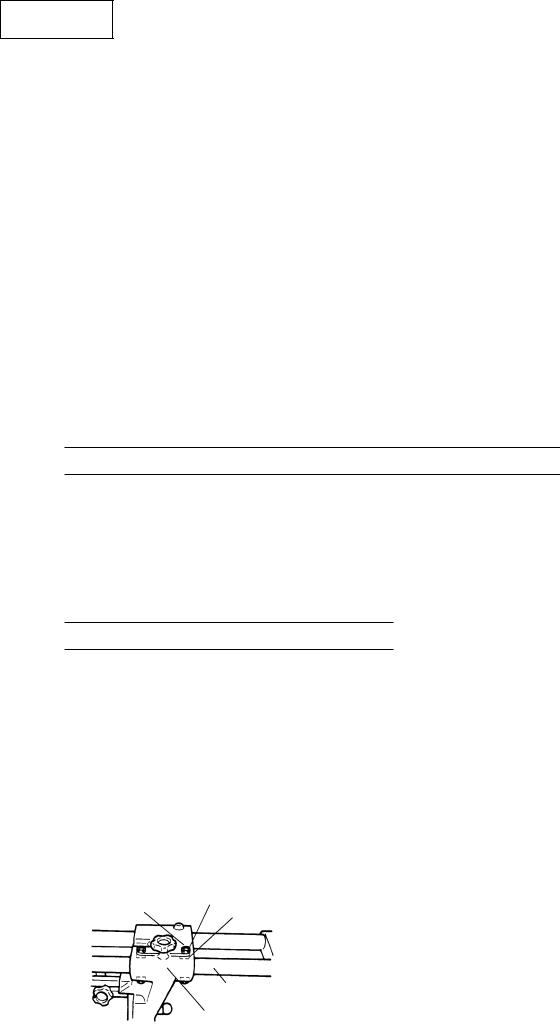
English
(3) Lift the safety cover and mount the saw blade.
 WARNING: When mounting the saw blade, confirm that the rotation indicator mark on the saw blade and the rotation direction of the side cover (L) (see Fig. 1) are properly matched.
WARNING: When mounting the saw blade, confirm that the rotation indicator mark on the saw blade and the rotation direction of the side cover (L) (see Fig. 1) are properly matched.
(4)Thoroughly clean washer (C) and the bolt, and install them onto the saw blade spindle.
(5)Press in the spindle lock and tighten the bolt by turning it to the left by 10mm box wrench as indicated in Fig. 42-b.
 CAUTION: * A dust guide is installed inside behind the side cover (L).
CAUTION: * A dust guide is installed inside behind the side cover (L).
When removing or installing the saw blade, do not make contact with the dust guide. Contact may break or chip saw blade tips.
*Confirm that the spindle lock has returned to the retract position after installing or removing the saw blade.
*Tighten the bolt so it does not come loose during operation.
Confirm the bolt has been properly tightened before the power tool is started.
2.Dismounting the saw blade
Dismount the saw blade by reversing the mounting procedures described in paragraph 1 above. The saw blade can easily be removed after lifting the safety cover.
 CAUTION: Never attempt to install saw blades larger than 10" (255mm) in diameter. Always install saw blades that are 10" (255mm) in diameter or less.
CAUTION: Never attempt to install saw blades larger than 10" (255mm) in diameter. Always install saw blades that are 10" (255mm) in diameter or less.
OVERLOAD PROTECTIVE DEVICE FOR POLY-V-BELT
The power of the motor is transmitted to the saw blade by a Poly-V-Belt. When the Poly-V-Belt becomes overloaded, the overload protective device cuts off the current to stop the motor.
In this case turn the switch off immediately and raise the handle to its initial position. Then turn the switch on and after running the tool for 20 seconds without a load for cooling of the motor. Then start the cutting operation.The Poly-V-Belt or the motor will be damaged if the overload protective device turns off frequently.
 CAUTION: When the overload protective device stops the motor, the motor will start by turning the switch on after turning it off. When turning the switch on, make sure that the saw blade is not halfway in the material.
CAUTION: When the overload protective device stops the motor, the motor will start by turning the switch on after turning it off. When turning the switch on, make sure that the saw blade is not halfway in the material.
MAINTENANCE AND INSPECTION
 WARNING: To avoid an accident or personal injury, always confirm that the trigger switch is turned OFF and the power plug has been disconnected from the receptacle before performing any maintenance or inspection of this tool.
WARNING: To avoid an accident or personal injury, always confirm that the trigger switch is turned OFF and the power plug has been disconnected from the receptacle before performing any maintenance or inspection of this tool.
1. Inspecting the saw blade
Always replace the saw blade immediately upon the first sign of deterioration or damage.
A damaged saw blade can cause personal injury and a worn saw blade can cause ineffective operation and possible overload to the motor.
 CAUTION: Never use a dull saw blade. When a saw blade is dull, its resistance to the hand pressure applied by the tool handle tends to increase, making it unsafe to operate the power tool.
CAUTION: Never use a dull saw blade. When a saw blade is dull, its resistance to the hand pressure applied by the tool handle tends to increase, making it unsafe to operate the power tool.
2. Adjusting a loose slide pipe
8mm Hex. Socket |
8mm Nut |
|
Bushing |
||
Head Screw |
Slide Pipe (A)
Holder (A)
After extended use of the power tool, the slide pipe (A) and the bushing can become loose due to vibration. Never operate the tool if any components are loose to avoid personal injury.
(1)Loosen the 8mm nut and tighten the four 8mm hexagon socket set screws until the power tool operates smoothly without looseness.
(2)Properly tighten the 8mm nut after completing these adjustment.
Fig. 43
24
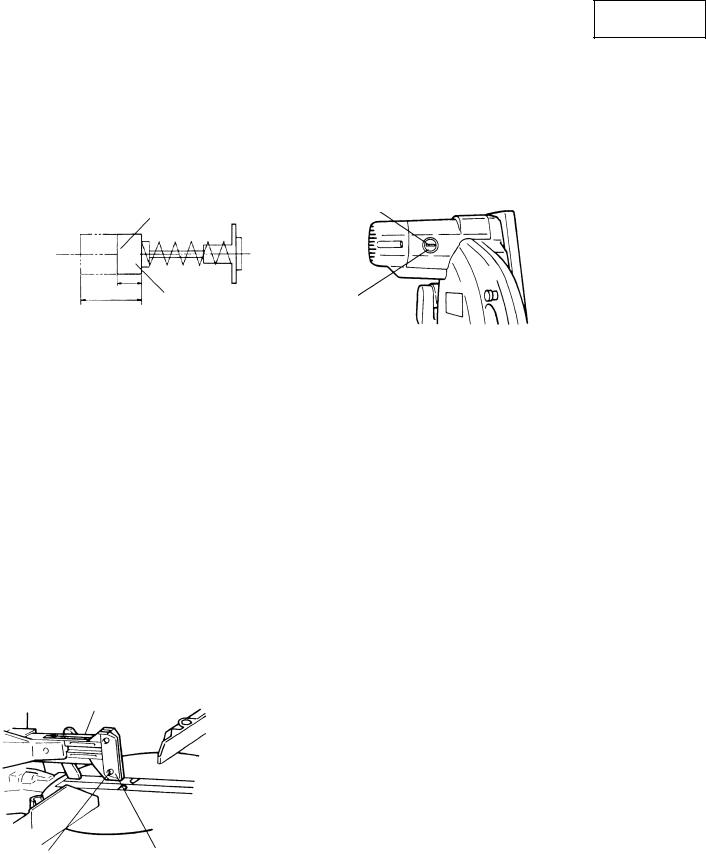
English
3. Inspecting the carbon brushes (Fig. 44 and Fig. 45)
The carbon brushes in the motor are expendable parts.
If the carbon brushes become excessively worn, motor trouble might occur.
Therefore, inspect the carbon brushes periodically and replace them when they have become worn to the wear limit line as shown in Fig. 44.
Also, keep the carbon brushes clean so that they will slide smoothly within the brush holders.
The carbon brushes can easily be removed after removal of the brush caps (see Fig. 45) with a slotted (minus) screwdriver.
Wear Limit Line
43
1/4" (6mm) |
No. 43 indicates the last |
|
|
11/16" (17mm) |
two numbers of carbon |
|
brush Code No. |
Groove for Driver
Brush Cap
Fig. 44 |
Fig. 45 |
4. Inspecting the mounting screws
Regularly inspect each component of the power tool for looseness. Re-tighten mounting screws on any loose part.
 WARNING: To prevent personal injury, never operate the power tool if any components are loose.
WARNING: To prevent personal injury, never operate the power tool if any components are loose.
5. Inspecting the safety cover for proper operation
Before each use of the tool, test the safety cover (see Fig. 7) to assure that it is in good condition and that it moves smoothly.
Never use the tool unless the safety cover operates properly and it is in good mechanical condition.
6. Storage
After operation of the tool has been completed, check that the following has been performed:
(1)Trigger switch is in OFF position,
(2)Power plug has been removed from the receptacle,
(3)Lock-off button has been removed and stored in a secure place.
When the tool is not in use, keep it stored in a dry place out of the reach of children.
7. Replacement of Guard (C)
Guard
After extended use of the tool, sometimes the groove of the Guard
(C) becomes wider. It should be replaced in this case.
When replacing with a new one, loosen the four 4mm flat head screws and remove the Guard (C). After replacing, make a groove on it. Refer to “1. Cutting a groove on the guard” on page 13.
4mm |
Guard (C) |
Flat Hd. Screw |
|
Fig. 46
25
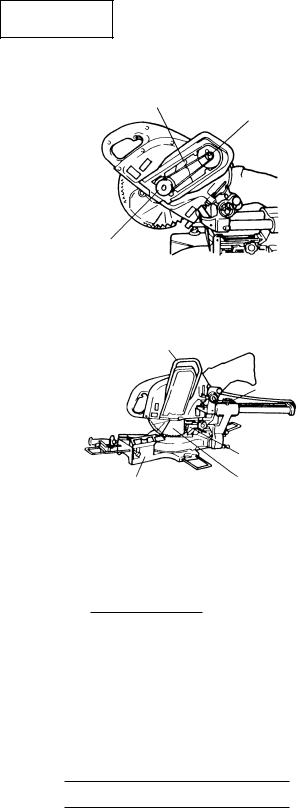
English
8. Replacement of Poly-V-Belt
Poly-V-Belt
Pulley (A)
Pulley (B)
Fig. 47
The power of the motor is transmitted to the saw blade by a Poly- V-Belt. When the Poly-V-Belt is broken or damaged, remove the belt cover by loosening the four 5mm screws (refer to Fig. 2) and replace the damaged one with the new one.
When connecting the belt on pulleys, first connect 2 or 3 teeth of Poly-V-Belt to the grooves of the pulley (A) and pulley (B). Then turning the pulley (A) and pulley (B), connect all 10 teeth of the belt to the pulleys.
9. Handle (for transportation and carrying)
Handle for Transportation
Slide
Securing
Knob
For transportation purpose, pull up the handle retracted in the gear case with one hand and hold the base at the left end grip section with the other to carry.
NOTE: Before transporting or carrying, position saw blade against guard and tighten slide securing knob to stop slide motion.
Guard
Base |
Blade |
Fig. 48
10. Lubrication
Lubricate the following sliding surfaces once a month to keep the power tool in good operating condition for a long time (see Fig. 1 and Fig. 2). Use of machine oil is recommended.
Oil supply points:
*Rotary portion of hinge *Rotary portion of vise assembly
*Sliding portion of slide pipe (A) and slide pipe (B)
11. Cleaning
Periodically remove chips, dust and other waste material from the surface of the power tool, especially from the inside of the safety cover with a damp, soapy cloth. To avoid a malfunction of the motor, protect it from contact with oil or water.
SERVICE AND REPAIRS
All quality power tools will eventually require servicing or replacement of parts because of wear from normal use.To assure that only authorized replacement parts will be used and that the double insulation system will be protected, all service (other than routine maintenance) must be performed by an AUTHORIZED HITACHI POWER TOOL REPAIR CENTER ONLY.
NOTE: Specifications are subject to change without any obligation on the part of HITACHI.
26
